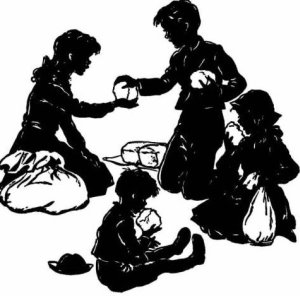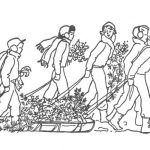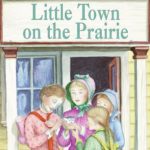I grew up reading books mostly published before 1970, ones that reflected the values of previous generations and knocked me completely out of step with my peers. I wasn’t aware of how much those books were products of a particular place and time, and so I thought that their values were timeless, universal.
For instance, through childhood reading it became readily apparent to me that a normal, well-balanced family has four children. The Boxcar Children has a quartet of resourceful youngsters, two boys and two girls. The Little House books’ Ingallses (eventually) have four daughters, Little Women‘s Marches have four daughters, Elizabeth Enright’s Melendy Family has two boys and two girls, Eunice Young Smith’s Jennifer books have two boys and two girls. In Jennie Lindquist’s Golden Name Day series, Nancy Bruce is an only child—but she goes to live with her adopted grandparents and becomes a unit with her three adopted cousins (all girls). Lenora Mattingly Weber’s Malone family has four children, three girls and a boy.
I also knew from my reading that if you’ve experienced an illness or trauma, the solution is to go to the country (or the Alps, the moors, the woods—anywhere remote.) Fresh air and sunshine will restore you. (See Heidi, The Secret Garden, and Understood Betsy.) Better yet, pick up your whole household and move to the country (along with your two parents and three brothers and sisters and live-in housekeeper.) Your house will have a cupola on top. There will be a subplot about being kidnapped by gypsies, who will actually turn out to be allies (see Eunice Young Smith’s Jennifer books and Elizabeth Enright’s Melendy Family books.)
Even if you don’t live in the country, a really interesting house will have nooks, crannies, hiding places, cool attics. Like Jo in Little Women, you can hang out up there writing melodramas and eating apples. Maybe, like Heidi, you’ll have a sleeping loft, or like Nancy Bruce, you’ll find a cute little house in the woods and inside, a crystal tree with a mysterious and romantic story attached to it. Or maybe, like the Melendy kids, you will discover a secret room.
If you’re a pioneer girl, you’ll do the extreme version of moving to the country or occupying a cool house. You’ll live in log cabins and sod houses as you go further and further west every few years—never east. Eastward movement is embarrassing and shameful. Only wimps move back east. (See Wilder’s Little House series.)
A really good heroine will help other people heal by her very presence. (See Anne of Green Gables, Pollyanna, A Little Princess, The Secret Garden, The Golden Name Day, and the Jennifer series.) A really great heroine works miracles. Like Nancy Bruce, who helps her lame friend Alex walk again. Or Mary Lennox, who helps her lame cousin Colin walk again. Or Heidi, who helps her lame friend Klara walk again. Or Jennifer, who helps her lame friend Sarabeth—whose name evokes both Heidi’s wheelchair-bound friend Klara and the sickly March sister, Beth—to—guess what?—walk again.
Many times, the miraculous nurturing powers of these literary heroines come from their very essence, not their effort, not even their touch. The title character of Donna Parker at Cherrydale enables a mute boy to talk and a grieving concentration camp survivor to find joy in life again. Sara Crewe, Anne Shirley, and Pollyanna simply inspire others through their charm, dignity, imagination, and optimism. “You are always making people happy,” a character tells the title character in Anne of Windy Poplars. “Why, whenever you come into a room, Miss Shirley, the people in it feel happier.”
If you are dismissed as ugly by adults or peers, but have high cheekbones, never fear—that’s universal code for “future beauty.” If others comment regularly on your starry eyes, that’s also good. Dreaminess means that you’re imaginative. The more criticism and/or teasing that you endure as a child, the greater will be your eventual triumph. (See Rachel, the vastly underestimated high-cheekboned heroine of Noel Streatfeild’s Dancing Shoes. Or starry-eyed Jennifer in Young’s series. Or awkward young Hans in Eva Moore’s The Fairy Tale Life of Hans Christian Andersen, who grows up to become a world-renowned author to whom all of the citizens of his home town raise their torches.)
Furthermore, really sensitive, imaginative characters make up whimsical stories about flowers and fairies. Anne delights in giving ornate names to ordinary places; Jennifer fantasizes that she can talk to bumblebees. When Anne, in Anne of Avonlea, falls through the roof of an old duck house, she is stuck hanging there while her friend goes for help, forced to draw on her own inner resources to pass the time. No problem. Anne entertains herself by working out a “most interesting dialogue between the asters and the sweet peas and the wild canaries in the lilac bush and the guardian spirit of the garden.”
In contrast to all of the lessons I learned from books, there were only three children in my family, my childhood home was a boring, serviceable split level built in 1965, I was never sent to the country to recover from anything nor did my family ever pick up and move to a pastoral setting. I did not have high cheekbones and when my eyes got starry my teachers told me to stop daydreaming and pay attention. I never helped anyone lame walk again, and I was secretly ashamed that I didn’t care what the bees would say to the flowers if they could all talk.
If these books failed to reflect my own white, middle-class reality, their values undoubtedly seemed foreign to many, many other readers. But for the most part, I didn’t feel inadequate or diminished by these books. I was too busy living vicariously through them, becoming these characters, surprised to close a book and remember that I was me, in my own room, in my own life, but still richer for the journey I’d just undertaken.



